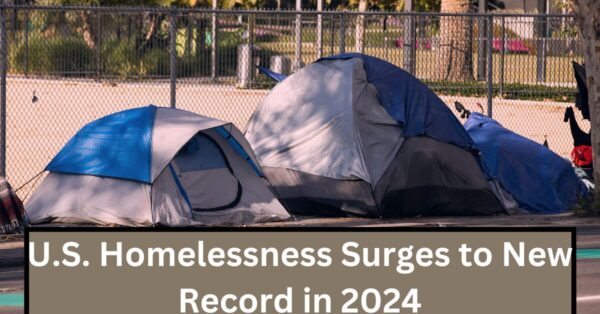U.S. Homelessness Surges to New Record in 2024 , Know Why?
The United States recorded the highest ever increase in homelessness in 2024, at more than 18% year over year. The population of homeless people surged to around 771,480, the largest since the U.S. Department of Housing and Urban Development started releasing comparable statistics in 2007.
Factors Contributing to the Surge
Many contributory factors to this dire upsurge have been identified. A few of them are described as follows:
– Shortage of affordable housing: It is the main cause for homelessness. Housing has grown relatively expensive, hence greatly surpassing wage growth over the past couple of decades.
– Natural Disasters: Events like the brutal Maui wildfire left thousands without homes and worsened homelessness. At night on HUD’s count, more than 5,200 people were in emergency shelters in Hawaii.
– Inflow Migration: New York, Chicago, and Denver have witnessed a huge increases in populations of homeless persons over the recent past after the recent inflow of migrant families who have sought asylum. The intake has overwhelmed the local resources as well as the capacity for shelters.
Demographics
Increases have not been uniform across the board in this trend.
– Families with Children: Almost 40% rise in homelessness by families with children, that is more households cannot sustain stable housing.
-Veterans: The trend follows but homelessness of veterans has reduced by 8%. In fact, homelessness among veterans has hit an all-time low of 32,882. Such a reduction is said to have occurred due to targeted programs and services in providing housing solutions for homeless veterans.
These were –
Racial Inequity: African Americans make up 12% of the country’s population, but as high as 32% of homeless individuals. And thus, there is manifest racial inequality in housing.
Governmental Response and Future Challenges:
The federal government and state and local agencies have initiated a number of responses to the mounting homelessness crisis. However, the problems continue to endure because of the complexity brought by housing affordability, economic conditions, and social services. In this respect, another layer of complexity was posed for policy responses with the recent Supreme Court decision in Grants Pass v. Johnson, allowing cities to prohibit homeless encampments.
Such an issue of complexity necessitates a multifaceted response in investing in affordable housing, supportive services, and policy provisions that correct the source problems of homelessness. A multilayered attack by the various echelons of government as well as community efforts would do this justice on the ever-present nation-wide increase in homelessness.

What to Look For In 2025:
Homelessness will be a huge issue in 2025. With various initiatives already in the pipeline to help ease the situation, experts say this will only be incremental progress unless transformative changes happen.
– Policy Interventions: Federal and state governments will increase funding for affordable housing initiatives, and these efforts will not affect the economy until the latter half of the year.
–Climate Change Impacts: In the wake of the current and continued climate change, natural disaster frequency and intensity, particularly those associated with global warming, may bring along with it another wave of displacement and homelessness.
Economic Uncertainty Soaring inflation and economic insecurity deepen the housing insecurity of various vulnerable populations, including the poor groups.
– Community Innovations: Where cities innovate, many small towns will now find creative solutions that work, such as community tiny home communities and rapid rehousing programs, which might now begin to ease up on the pressures at the shelter systems.
While there is hope that increased awareness and investment will bring improvements, 2025 is likely to be a critical year in determining whether the United States can turn the tide on homelessness or if the crisis will continue to worsen. In this process, collaborative, long-term efforts will be needed to achieve sustainable progress.
Conclusion
This is record homelessness in 2024: a deepening crisis of systemic problems with housing shortages, economic inequality, and climate change. And as the country enters 2025, this will require efforts from all levels of government to move toward increased investment in affordable housing and targeted support for vulnerable populations. But much hard work remains to be done on the path ahead. If continued, it can give a clear direction toward making housing stable for all. Read morehttps://usavartalu.com/




